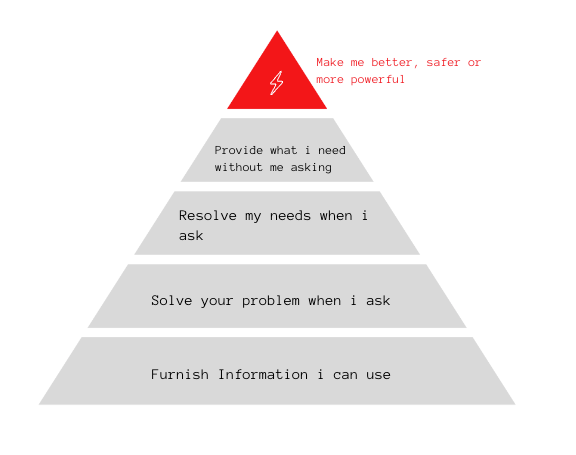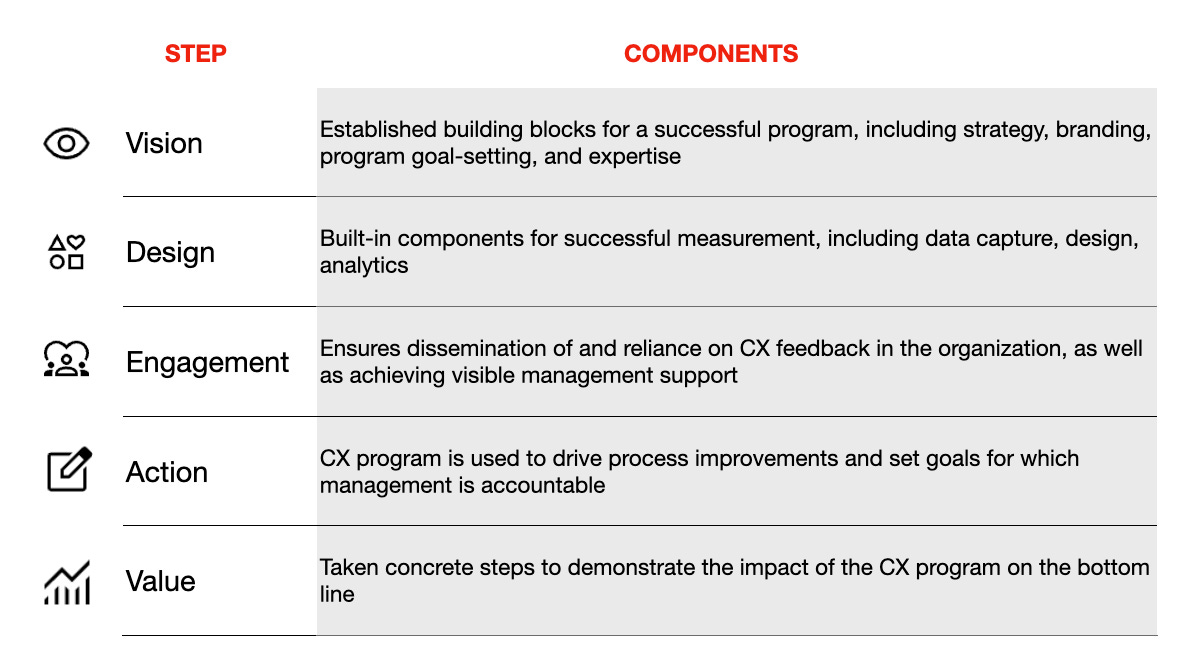Gartner's Customer Experience Management Maturity Model Explained
Time to Be More Customer-Centric
What is the Customer Experience Maturity Model
The Customer Experience Maturity Model helps you identify where your CX efforts stand today and where to focus your efforts on your digital transformation journey. Use the CX Maturity Model to assess your current development level, determine where improvement is needed, and help map out future goals to transform your CX from a cost center to a value driver that delights customers.
Customer experience is the key element to keep or grow business in this fast-growing technology era.
Setting a company metric and sharing it with the broader organization to meet the metrics will help organizations to measure customer experience maturity. Day by day technologies are changing and it’s become challenging to meet customer experience in the competitive market. To beat the competition and to measure customer experience, many organizations come up with different models called Customer Experience Management Maturity Models. The goal of all the models is to gauge the maturity of the CX ( customer experience).
We will take an example of Gartner’s Customer Experience Management Maturity Model. Similarly, organizations can adopt different models based on their industry and organization structure.
How marketers can move up the customer experience pyramid to drive loyalty, satisfaction, and advocacy.
When a consumer is stranded on the side of the road with a flat tire, and a phone, all they want is a simple, how-to video that explains where to put the jack and how to easily loosen the first lug bolt. The content could even be computer-generated as long as it hits the mark in terms of having the right information.
It seems simple from a consumer perspective, but too often, brands fail to deliver the basic information and experiences that customers expect and need.
According to the 2017 Gartner Customer Experience in Marketing Survey, 81% of marketing leaders responsible for customer experience (CX) say their companies will mostly or completely compete on the basis of CX in two years. Yet only 22% say their CX efforts have exceeded customer expectations.
It starts by furnishing the key information customers need, in their moment of need, such as a how-to video to fix a flat tire.
CX is underperforming where it matters most — for customers — and what brands can do to move beyond just solving today’s problems for today’s customers using today’s processes.
The Gartner Customer Experience Pyramid is a framework for building effective experiences that lift satisfaction, loyalty, and advocacy and start to chip away at the chasm between expectation and reality.
Stage No. 1: Furnish information I can use
The journey to better loyalty, advocacy, and satisfaction begins with meeting customers’ basic needs. This stage and those that immediately follow are tactical, reactive, and focused on removing irritants that get in the way of better experiences and satisfaction.
Stage No. 2: Solve your problem when I ask
At this stage, the customer’s problem is the company’s problem (or that’s how the customer sees it). Moving beyond the foundational level means solving the company’s basic issue when the customer asks. In the case of a flat tire, this would mean providing the bare minimum tire replacement service a company is obligated to provide, such as using the customer’s 40-mph-limit spare doughnut in the trunk.
Stage No. 3: Solve my needs when I ask
This stage means it’s time for the brand to address specific needs, wants, and requests. For example, when a customer has a flat tire, they want the car to drive as it was before they got the flat. The service agent might arrive with a fully functional replacement tire or fix the flat tire on the spot.
Stage No. 4: Provide what I need without me asking
Moving beyond resolving customer needs starts to enter the realm of aspirational customer service. It requires deeper knowledge and data about the customer and effective processes to execute the experiences. In the case of roadside repair, a mobile service technician would not only fix a flat tire to its near-original state but also check the rest of the car and fix a leaky radiator during the same service call. That type of CX drives significant satisfaction and is quite difficult to execute.
Stage No. 5: Make me better, safer, or more powerful
The top of the pyramid is reserved for exceptional CX practices that fundamentally redefine the customer experience and what customers can become as a result of using the product or service. Not just providing customers with superpowers, but making them feel like they have superpowers. This level might be as simple, and as complex, as dispatching a luxury self-driving vehicle to whisk a stranded customer to work at the push of a button — and delivering their fixed, washed, and waxed car to their driveway while they are at work.
As companies move up the pyramid they need to take steps to reduce risk, such as gathering appropriate voice of customer data and even expanding their vision to include the entire customer journey.
For anyone who has endured pouring rain while waiting for a cab to arrive, ordering and waiting for transportation from the comfort of home starts to feel like a superpower.
Importance of Customer Experience
A remarkable customer experience is critical to the sustained growth of any business. A positive customer experience promotes loyalty, helps you retain customers, and encourages brand advocacy.
Today, customers have the power, not the sellers.
Who gave them this power? Us — with help from the world wide web.
Customers have a plethora of options to choose from at their fingertips plus the resources necessary to educate themselves and make purchases on their own.
This is why it's so important to provide a remarkable experience and make them want to continue doing business with you — customers are your best resource for growing your brand awareness.
So, how can you measure your customer experience to determine what you're doing well and where there's room for improvement?
How to Make a Great Customer Experience
To make a great customer experience, make a customer journey map, create buyer personas, establish a positive connection with customers, ask for and act on feedback, create helpful content, and build a community.
The most important part of creating a great customer experience is understanding the entire journey a customer takes. You need to think about your customer journey map (or if you don't have one, create one). This will help you understand every touch point that you have with your customers. From there, you can focus on how to make each of those touch points a positive experience for the customer.
How to measure your CXM maturity
Using the Gartner CX management maturity model your company can determine the current health and direction of your CX program, and use this as a starting point on to build from.
The CXM maturity model consists of five levels of maturity, ranging from scenarios in which organizations have a fragmented focus to higher levels in which CXM is a fully-funded, enterprise-wide strategy that has achieved cultural change.
The five levels of CXM maturity are:
Initial
Developing
Defined
Managed
Optimized
Most large organizations are at Level 1 or Level 2 maturity. The bar chart below represents Gartner’s estimate of the percentage of organizations at each level of maturity.
How mature are you?
To help you do a quick measurement of your organization’s CX management maturity level, here is a quick snapshot of each one:
Level 1 – Initial The company’s focus on improving the customer experience is fragmented. There is no CXM vision yet. There is no CXM strategy. Often individuals within the company acknowledge the need for CXM, but the senior executives are not onboard.
Level 2 – Developing A vice president of customer experience may have been appointed. Gaps have been identified. Various groups within the company have recognized the need to take action regarding CXM but there is no C-suite buy-in yet.
Level 3 – Defined Senior management has outlined a vision. A CXM current state has been determined and a strategy for how to reach the “to be” state has been developed. Various departments within the organization have taken up the CXM charge.
Level 4 – Managed The organization’s executives have agreed that customer experience is as important as profitability, and organization-wide the employees are sold on following through on delivering an exceptional customer experience. In other words, customer experience improvement has been systematized.
Level 5 – Culture Change The commitment to an exceptional customer experience is embedded in the DNA of the company culture. Employees think customers first without being asked, or having to be given incentives or pressured to do so. Management has given employees the power to take action and innovate independently. The goal, organization-wide, is to deliver and maintain customer service excellence.
As you can see, with a tool such as the Gartner CX Management maturity model your organization can conduct an objective measurement of the current state of its CX efforts and plan for future improvements; improvements that will further enhance customer satisfaction, loyalty and advocacy.
The bottom line: whether you’re a weekend handyman or a CX manager, careful measurement is the key to building success.
🔥 Top three quotes from our Instagram page
If you do build a great experience, customers tell each other about that. Word of mouth is very powerful. ― Jeff Bezos
We can't be in survival mode. We have to be in growth mode. ― Jeff Bezos
Define what the product will do before you design how the product will do it ― Alan Cooper
Tech Snippets :
Amazon CEO Andy Jassy said the company won’t ask corporate workers to return to the office, aligning them with Meta, but not Google.
Twitter Circle, a feature that lets you tweet to a preselected group of up to 150 people, is now available to everyone.
📺 Useful: All the codes Netflix uses to categorize movies so you can navigate straight to your favorite genres.
⛽ How to: How to use Google Maps to save on gas.
⌨️ Useful: A database of keyboard shortcuts for websites, apps, and more.
🖥️ A LinkedIn viral post generator. You get to choose your own “cringe” level.
😴 How to: Tips for falling asleep the night before an early morning.








